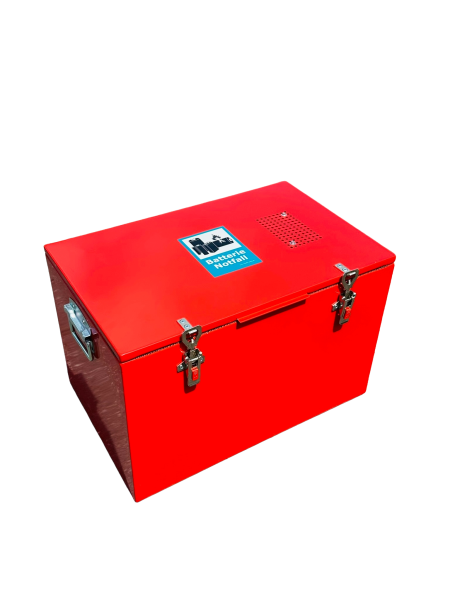- Article no: PMSVG1HGEN2

Questions about the article?
Our staff member Petra Fürbeck is happy to help you:
+49 (0) 7151 - 256 4817 or info@lion-care.com
| max. gross mass: | 44 kg |
| Empty weight: | 23,5 kg |
| Handling the filling material: | Backfill |
| Material name: | Sheet steel |
| Packaging group: | Packaging group I |
| UN packaging code: | UN 4A/X44/S/*/B/Müller-250097 |
| Areas of application: | defective batteries, fire-protected storage, stationary containment, Storage, Extinguishing / Fire fighting, Transportation |
| External dimensions: | 600 x 400 x 400 mm (LxBxH) |
| Filling material: | 2x Extover Löschgranulat 2,7 kg |
| Internal dimensions: | 530 x 330 x 335 mm (LxBxH) |
PAUL MÜLLER HAVARIEBOX GEN2 - Compact protection for defective small lithium devices
Numerous mobile devices with lithium energy storage systems are used every day in fire stations, industrial plants and public facilities. If batteries become conspicuous or are damaged, a fire hazard can quickly arise. The emergency box Gen2 from PAUL MÜLLER offers a compact solution for the safe storage and transportation of such small devices - such as smartphones, battery-powered lights or notebooks.
The lockable lid limits the spread of fire to the inside of the box. At the same time, the defined outgassing opening in the lid with integrated filter medium massively minimizes the escape of smoke and venting gases. This allows a damaged energy storage unit to react in a controlled manner without the danger spreading to the outside.
Technical features and dimensions
The box measures 600 mm in length, 400 mm in width and 400 mm in height on the outside. The interior is approximately 530 mm long, 330 mm wide and 335 mm high, which corresponds to a volume of approx. 58.6 liters. The weight without extinguishing agent is approx. 23.5 kg. The steel box is powder-coated in RAL 3020 (signal red) and has a thermally insulating inner lining.
Safe pressure relief and UN approval
The emergency box Gen2 is equipped with defined pressure relief via the filter medium in the lid, which enables controlled extraction of excess pressure, smoke and gases. The box has UN approval for safe transportation. The box can be used for lithium batteries up to 1,000 Wh and is labeled accordingly, including the UN approval number and the stickers "battery emergency" and "emergency box". There are also recommendations for use on the box.
Versatile use in the fire department, industry and administration
The compact design allows the box to be loaded onto the emergency vehicle or stored in the equipment shed to save space. In industrial companies, the boxes are kept at defined locations or brought to the scene of an emergency by plant fire departments as required. The emergency boxes are also established in administrative buildings and public facilities as an effective immediate measure in the event of lithium emergencies.
Extover extinguishing granulate for increased safety
The box can be filled with 2 x 2.7 kg bags of Extover dry extinguishing agent. This special extinguishing agent made from expanded glass granulate is non-flammable, reusable (if no fire has occurred), recyclable and environmentally friendly. It displaces oxygen, binds gases and vapors and thus supports safe firefighting and disposal. Two 2.7 kg bags are included in the price!
Robust and durable construction
The steel container with powder-coated surface and thermally insulating inner lining guarantees robust and long-lasting usability for daily use in various areas of application.
PAUL MÜLLER SAFETY - Special solutions for demanding requirements
Paul Müller Safety stands for tailor-made solutions that are specially designed for challenging tasks. The company offers a wide range of products tailored to the needs of fire departments, rescue companies and civil protection.
The requirements for handling electric vehicles and battery storage systems are becoming increasingly complex and diverse. Paul Müller Safety is a leading specialist in the safe transportation and storage of damaged electric vehicles and large batteries. Paul Müller Safety's products play a crucial role in the management of large transportation tasks and efficient logistics in day-to-day operations.
The company has developed specially adapted products for both fire departments and disaster control that meet the requirements of these areas of application. Products have also been developed to meet the specific needs of towing and recovery companies. Paul Müller Safety's many years of experience and comprehensive expertise enable it to offer innovative solutions that meet the highest standards in terms of safety and efficiency.
Future-oriented
Lithium-ion batteries will be indispensable in all industrial applications in the coming years. However, if used improperly, batteries can pose a potential hazard during production, storage and transportation that should not be underestimated. By purchasing these boxes, you protect yourself against major financial losses right from the start. International customers from the automotive and energy supply sectors, among others, rely on this proven technology.
In use for you
If you have any questions, please do not hesitate to contact us. We look forward to hearing from you.
| max. gross mass: | 44 kg |
| Material: | Steel |
| Volume: | 58, 6 l, 58,6 l |
| Empty weight: | 23,5 kg |
| Coding: | 4A |
| Filling material supplied: | Expanded glass granulate (bulk material) |
| Type of packaging: | Dangerous goods packaging < 450 liters or < 400 kg net |
| Handling the filling material: | Backfill |
| Material name: | Sheet steel |
| Packaging group: | Packaging group I |
| UN packaging code: | UN 4A/X44/S/*/B/Müller-250097 |
| Areas of application: | defective batteries, fire-protected storage, stationary containment, Storage, Extinguishing / Fire fighting, Transportation |
| External dimensions: | 600 x 400 x 400 mm (LxBxH) |
| Filling material: | 2x Extover Löschgranulat 2,7 kg |
| Internal dimensions: | 530 x 330 x 335 mm (LxBxH) |
Das hängt von verschiedenen Faktoren ab, die man berücksichtigen muss:
- Größe der Batterie(n)
- Zustand (z.B. nicht kritisch, defekt, defekt kritisch oder Prototyp)
- Leistung
Transportboxen gibt es in vielen verschiedenen Größen und Ausstattungen. Es ist jeweils beim Produkt angegeben, für welche Verpackungsgruppe die Box geeignet ist.
Mehr dazu in unserem Blogartikel:
https://www.lion-care.com/aktuelles/blog/transportvorschriften-regeln-und-sicherheitsmassnahmen
Denken Sie auch bei nicht kritischen Batterien daran, diese vor Erschütterungen zu schützen und entsprechend Füllmaterial mitzubestellen, wenn dieses nicht bereits in der Box enthalten ist.
Ja. Sollte eine Batterie einen kritischen Zustand erreichen und einen Brand auslösen, verhindert eine Trennung der Akkus, dass dieser sich ausbreitet und multipliziert.
Grundsätzlich sollte das Dämm-/Schutzmaterial alle Seiten des Behälters auskleiden. Die Batterien werden zwischen einzelnen Schichten gelagert.
Wir haben auch Behälter im Programm, die das Schutzmaterial bereits in der Außenwand integriert haben. Hier ist keine weitere Schutzschicht notwendig.
Die technischen Grundsätze für Lager- und Transportlösungen sind sehr ähnlich. Die Transportboxen werden zusätzlich gemäß ADR umfangreichen Tests (Falltest, Brandtest …) unterzogen, um die Erfüllung der ADR-Regularien zu bestätigen. Die Verpackungsvorschriften sind umfangreich und gesetzlich geregelt.
Vergleichbare Vorschriften zur Lagerung gibt es derzeit noch nicht. Dennoch führen Hersteller von Lagerboxen regelmäßig entsprechende Test durch.
Welcher Behälter der richtige ist, hängt von der Art der zu versendenden oder zu lagernden Batterie und der Größe ab.
Wenn Sie mehr zur Lagerung und zum Transport von Batterien erfahren möchten, finden Sie in unseren Blogartikeln die Antwort:
https://www.lion-care.com/aktuelles/blog/transportvorschriften-regeln-und-sicherheitsmassnahmen
https://www.lion-care.com/aktuelles/blog/lithium-ionen-akkus-sicherer-umgang-und-richtige-lagerung
Dem Transport von Batterien liegen die ADR-Regularien zugrunde.
Um einen geeigneten Transportbehälter für Lithium-Ionen-Batterien zu finden, sind Anzahl, Größe und Gewicht, Energiedichte und Zustand der Akkus ausschlaggebende Parameter. Die Auswahl ist komplex und sollte durch entsprechend geschultes Personal erfolgen. In unserem Team haben wir einen ausgebildeten Gefahrgutbeauftragten. Sprechen Sie uns gern an.
Kunststoffbehälter sind günstiger, jedoch nicht so langlebig wie Metallbehälter. Sie eignen sich bspw. für nicht kritische Batterien, defekte Batterien, Prototypen und End-Of-Life Batterien. Sie können sowohl für die Lagerung als auch für den Transport eingesetzt werden.
Metallbehälter werden z.B. benötigt, wenn es sich um kritisch defekte Batterien handelt.
Die genauen Verpackungsvorschriften für diese Fälle finden Sie im ADR oder Sie fragen einen zertifizierten Gefahrgutbeauftragten.
Bisher gibt es keine gesetzliche Vorschrift zur Lagerung von Lithium-Ionen-Batterien, was nicht bedeutet, dass man sie ohne geeignete Schutzvorkehrungen lagern sollte.
Am besten ist es, sich bei seinem Versicherer zu erkundigen, welche Maßnahmen er im Schadensfall als geeignet anerkennt.
Zum Beispiel könnte bereits eine geeignete Box als räumliche Trennung anerkannt werden.
Einen groben Überblick erhält man in dieser VDS Publikation des GDV:
https://shop.vds.de/download/vds-3103/ccb1d439-ad9d-47cb-a2b1-ace23e155610
Lesen Sie auch unseren Blogartikel zu diesem Thema:
https://www.lion-care.com/aktuelles/blog/lithium-ionen-akkus-sicherer-umgang-und-richtige-lagerung















